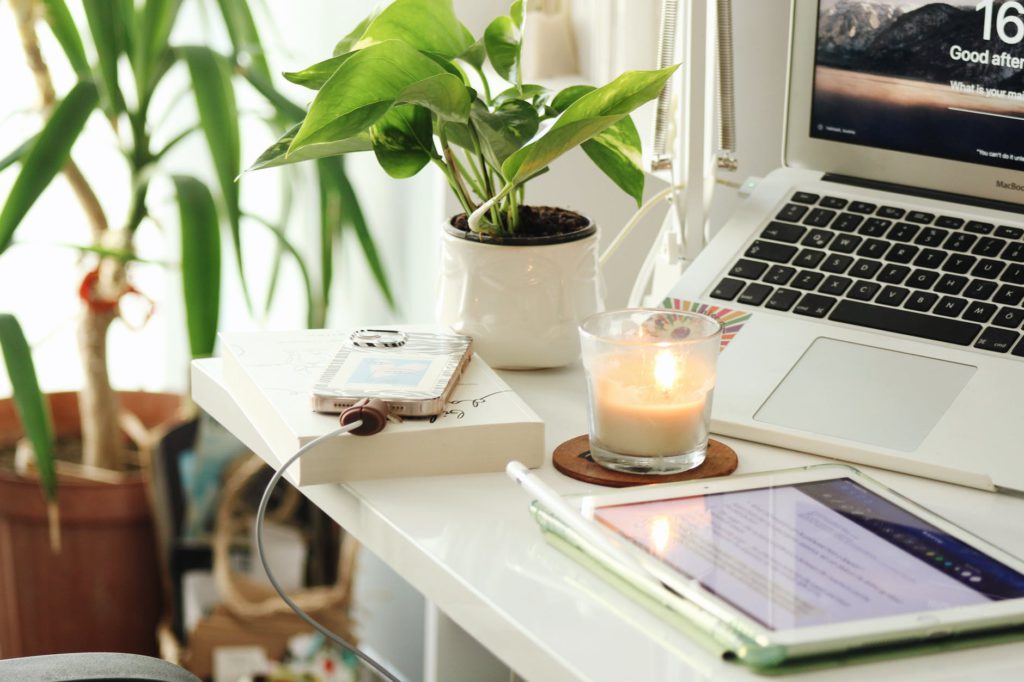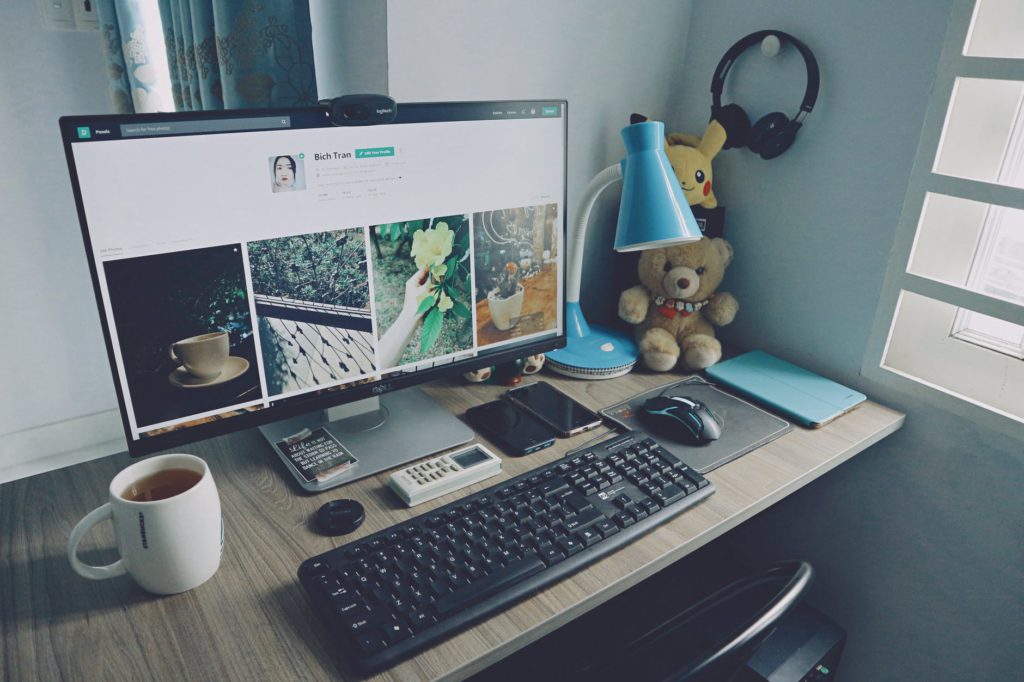While flexibility, autonomy and the absence of a long commute are all benefits that make working from home sound perfect, it’s not without its challenges.
Whether you’ve opted to freelance or you’re considering taking advantage of a new remote protocol at your company, it’s worth taking some time to think deeper about the specifics of your WFH lifestyle. A little planning can go a long way in making sure you’re ready to conquer any challenges along the way.
Getting Started: Your WFH Office
No matter what your living space looks like, setting up a comfortable place to work from home is a critical first step. According to a study from the University of Exeter, employees who have control over the design and layout of their workspace are happier, healthier and up to 32% more productive.
Cognitive scientist Anja Jamrozik suggests starting with five basics when setting up your space in Architectural Digest:
- Access to natural light
- A comfortable temperature
- Good air quality
- Comfortable furniture
- A strategy for minimizing distractions
Defining your space around these basics is an easy way to make sure you’re prioritizing your individual comfort level. Do you need a space heater? An upgraded office chair? Can you move your at-home set up in front of a window? Will installing a screen or purchasing noise-canceling headphones will help you stay on task?
Defining your workspace doesn’t necessarily mean you need a lot of square footage. Architect Donald Rattner offers this advice: “create a regimen of space.” A few strategically arranged items, such as family photos or a houseplant, can all trigger an “at-work” vibe to help you settle into your daily routine and feel more like you’re in the zone.

Rattner also offers a few additional tips for arranging your furniture and creating space.
Create more space for more open-mindedness. Facing your desk toward a blank wall locks your eyes in one direction. While you may not have the luxury of cathedral ceilings, turning your desk toward the center of the room can create feelings of openness.
Use sound for focus and creativity. A workspace that is too loud or too quiet can disrupt productivity. Depending on who else might be living in your workspace, consider finding a way to incorporate sound that inspires focus and creativity.
Related: Create a Comfortable Home Office Setup for Remote Work
Picking the Right Equipment for Your Home Office
All you need is a laptop and maybe a mouse to work from home, right? Think again! If you’re serious about working from home long term, selecting the right equipment is an important investment.
Furniture: Your Desk and Chair
Depending on your space and preference, you might consider adding a standing desk to your workspace. According to Start Standing, there are a variety of negative health outcomes associated with prolonged sitting. A standing desk is a great way to combat health risks and improve how you feel at work.
In one study published by the CDC, participants overwhelmingly reported feeling more comfortable, energized, healthier, more focused, more productive, happier and less stressed as a result of having a sit-stand device installed at their workstations.
While standing desks can range greatly from $100 to $500, you don’t have to spend hundreds of dollars to start experiencing some of the benefits. An on-desk platform can help you upgrade your setup to a standing desk more economically. If you go all-in on a standing desk, you could also save on a desk chair.

If you prefer a mix of standing and sitting or even sitting only, you’ll need to invest in a quality desk chair.
When it comes to comfort and productivity, folding chairs or kitchen stools aren’t the best options. Invest in an ergonomic chair to maximize your levels of productivity throughout the day.
Related: Work from Home and Love It with These Must-have Tools
Organization: Cutting Clutter and Managing Cords
Cord clutter can quickly get out of hand. You don’t need expensive gadgets or equipment to avoid a cord disaster. The Spruce has a few budget-friendly tips for managing cables and wires.
- Wrap wires. Twist ties are a great way to bundle cords to keep them together.
- Use labels. Attach a piece of tape to each wire before you bundle so you know which cord goes where.
- Avoid stashing. Use command strips underneath your desk to hook cords and keep them off the floor.
- Binder clips. Perhaps one of the most versatile pieces of office equipment, the metal hoop at the end of a binder clip can stop a cord from slipping out of place, while the clip can keep it close by and attached to your desk.
- Designate a cord basket. You might not use every cord all time, so consider stashing the ones you don’t use in a nearby basket so they aren’t cluttering your space when not in use.
Digital Technology: A Whiteboard
Consider up-leveling your work from home space with a digital whiteboard like Vibe. Whether you need the extra space for brainstorm sessions or presentations, or you’re doubling as a homeschooling parent, a digital whiteboard can help you break away from the standard computer desk setup.
{{< blog/cta-1 “Work from home effectively with the Vibe Smart Whiteboard” “https://vibe.us/products/vibe-smartboard-pro-75/” >}}
With an expansive list of app integrations, you don’t have to spend time going back and forth from computer to whiteboard to collaborate with your team or access your favorite tools.
Electronics: Headphones
Investing in a great pair of headphones can greatly improve the comfort and functionality of your home office, especially if you share it with others. Whether you’re looking to tune all noise out or add some calming noise, there are a variety of headphone options available. Some headphones also double as headsets, allowing you to both hear and speak with less background noise.
Beating Distractions at Home
Everyone faces different challenges when it comes to maintaining focus while working from home.
According to Forbes, the biggest task disrupter is half-focusing – and it’s especially common in Zoom meetings. Have you ever found yourself zoning out in a Zoom meeting, only to find yourself wondering what the meeting was even about after signing off?
By staying hyper-focused on one task at a time, you’re more likely to complete the task at hand quicker. One of the most effective ways to keep yourself focused on one task at a time is to take breaks. At an office, it’s often easier for you to transition to natural breaks in between tasks. At home, you might need to be more diligent about making time for breaks.
The PomoDoneApp can help you bring the benefits of the pomodoro technique into your work-from-home lifestyle by sending you alerts when it’s time to take a break.
Depending on your unique home life, distractions are also another common disrupter. If you’re dealing with family distractions, consider using headphones to keep the sounds of noisy kiddos from luring you away from your work. If you’re an avid social media user, consider shutting off notifications until you get your task list completed.
3 Tips for Maximizing WFH Productivity
Even with a solid plan in place for remaining on task, it’s not uncommon to find yourself experiencing periods where you’re having trouble being productive. Here are three tips for maximizing your productivity when you’re not in the office.
- Structure your day like you would if you were in the office.
When you transition to working from home, it can be hard to find a new routine, especially if you had one when you were working in an office. While you don’t have to keep your routine exactly the same, try to structure your day as closely as you would if you were in the office.
For example, if you normally start your day with a shower and breakfast before work, stick to it. Or, if you find that you’re more productive as soon as you wake up and you prefer a midday shower, go with that – but keep it consistent to establish a sense of routine.
- Work to your strengths.
According to the Wall Street Journal, self-awareness is a big piece of productivity. Before you start working from home, think about how you work best. Do you do your best writing in the morning? Do you prefer the television on in the background to maintain focus? When it comes to defining your work from home space and maintaining productivity, prioritize whatever it is that helps you be at your best. - Get away if you need to.
At some point, you might find yourself completely stuck in a productivity rut – it happens. Find a coffee shop, a library or any place where you feel particularly inspired, and spend a morning or an afternoon switching up your scenery. Getting away for a brief period of time can help you reset your mind so you can come back to your home refreshed.

Maintaining a Healthy Mind and Body
Before you start a new job, you probably do a few things both mentally and physically to prepare yourself for your first day. Transitioning to working from home is as big of a life change, so be sure you’re ready from a mind and body standpoint.
- While it’s helpful for productivity to structure your day like you would if you were at the office, it’s important to make sure you’re setting boundaries. Setting defined working hours is a perfect example of setting boundaries.
- While you may no longer have a commute, that natural boundary of having to physically leave your office to catch a train or make daycare pickup isn’t there anymore. In the absence of this boundary, it can be hard to walk away from your desk at quitting time, especially when your living situation might mean you’re looking right at your office all night long.
- While it may seem basic, maintaining a healthy diet and getting plenty of rest is also key. Boundaries can be especially helpful in getting good rest. According to a study from The Sleep Foundation, the use of screens before bed negatively impacts your quality of sleep. Keeping your work hours firm can help you avoid the temptation to “check one more thing” before snoozing.
As you prepare mentally and physically for working from home, it’s important to think about your workspace long-term — and prioritize it as an ongoing process. Think about the next five years and make a list of the things you might want to work toward to improve your space or make it more comfortable.
Related: Stuck at Home? Try These 8 Inspiring and Interactive Virtual Museum Tours
3 Solutions to the Most Common Work-From-Home Challenges
No matter how much you’ve prepared or how many tips and tricks you’ve read, it’s inevitable that you’re going to encounter a few challenges working from home. Don’t get discouraged. Here are the top three challenges facing people who work from home, and a few solutions for overcoming them.
- Isolation
Feelings of loneliness and isolation are one of the top challenges facing remote employees across all industries. If you were once in an office and now are working from home, it can be hard to suddenly go from seeing and interacting with your peers in person every day to only virtual contact. In Buffer’s recent State of Remote Work report, 20% of participants reported loneliness as their biggest struggle with remote work.
Depending on your comfort level, you can avoid isolation by prioritizing either virtual or in-person contact. Start by making a list of the people who make you feel happy. Create a task for yourself to reach out to as many friends, co-workers or family members as you can and schedule some check-ins. These don’t have to be long or formal, but they should be fun – so get creative with where and when you’ll connect.

- Communication Issues
If you’re used to regular office pop-ins or peeking across cubicles to communicate with co-workers, transitioning to tools like Slack or email can be tough to get used to.
According to MIT Sloan Management Review, face-to-face communication is considered high-bandwidth communication because you can transmit and receive the greatest amount of information in a given time period. If you’re struggling to get timely responses on Slack or worried about how your tone might be interpreted through email, consider asking for a quick video conference call to clear up any confusion.
- Collaboration Problems
Brainstorms and presentations are two examples of collaborative processes that are without a doubt harder in a work-from-home environment. If you’re struggling to find ways to engage team members, consider hosting meetings or brainstorms with a digital whiteboard. From real-time collaboration to organization, there are lots of ways to energize boring brainstorms with the help of a smart board.
{{< blog/cta-2 “Make remote collaboration work with Vibe” “https://vibe.us/lp/scenario-remote” >}}
Above all, working effectively begins and ends with you, the employee. Since every living space is different and all employees are unique, prioritize the things that will make you feel the most energized to get up and get to work each day. And if things aren’t working, don’t be afraid to switch it up and try new things or invest in new equipment.
Find out more about how Vibe can transform your home office and help you work from home more effectively.
